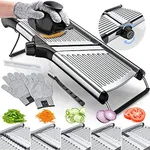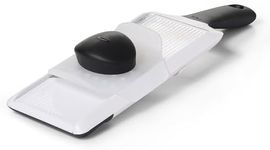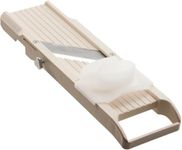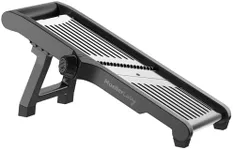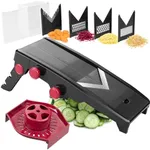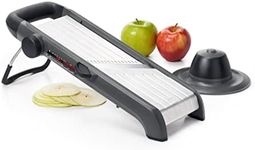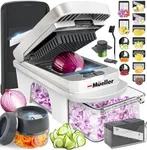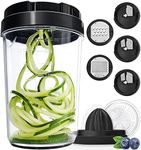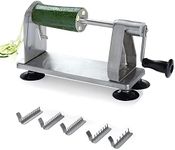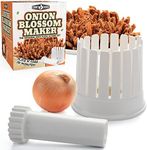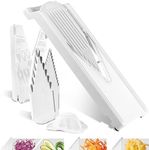Buying Guide for the Best Mandolin Slicers
Choosing the right mandolin slicer can make food preparation much easier and more efficient. Mandolin slicers are kitchen tools used to slice vegetables and fruits quickly and uniformly. When selecting a mandolin slicer, it's important to consider several key specifications to ensure you get the best fit for your needs. Understanding these specs will help you make an informed decision and find a slicer that suits your cooking style and preferences.Blade TypeThe blade type is crucial because it determines the kind of cuts you can make. Mandolin slicers typically come with straight, julienne, or wavy blades. Straight blades are great for making uniform slices, julienne blades are used for creating thin strips, and wavy blades are perfect for crinkle cuts. If you plan to use the slicer for a variety of tasks, look for a model that offers interchangeable blades. Your choice should depend on the types of cuts you need most often in your cooking.
Adjustable Thickness SettingsAdjustable thickness settings allow you to control the thickness of your slices. This feature is important because it provides versatility in your food preparation. Some mandolin slicers offer a few preset thickness options, while others have a dial for more precise adjustments. If you frequently need different slice thicknesses for various recipes, choose a slicer with a wide range of adjustable settings. For basic slicing needs, a few preset options may suffice.
Safety FeaturesSafety features are essential to prevent accidents while using a mandolin slicer. Look for models with handguards or food holders to protect your fingers from the sharp blades. Some slicers also have non-slip bases or suction feet to keep the slicer stable during use. Safety features are particularly important if you are new to using mandolin slicers or if you plan to use it frequently. Prioritize models with robust safety features to ensure a safe slicing experience.
Material and DurabilityThe material and durability of the mandolin slicer affect its longevity and performance. Common materials include plastic, stainless steel, and a combination of both. Stainless steel slicers are generally more durable and can handle tougher vegetables, while plastic models are lighter and easier to handle. If you need a slicer for heavy-duty use, opt for a stainless steel model. For occasional use or lighter tasks, a high-quality plastic slicer may be sufficient.
Ease of CleaningEase of cleaning is an important consideration because it affects how convenient the slicer is to use and maintain. Some mandolin slicers are dishwasher safe, while others require hand washing. Models with removable blades and simple designs are typically easier to clean. If you prefer low-maintenance kitchen tools, look for a slicer that is easy to disassemble and clean. This will save you time and effort in the long run.
Size and StorageThe size and storage options of the mandolin slicer can impact its convenience and usability. Compact slicers are easier to store and take up less counter space, making them ideal for small kitchens. Larger models may offer more features but can be bulkier to store. Consider the available space in your kitchen and how often you plan to use the slicer. Choose a size that fits your storage needs and is convenient for your cooking habits.



